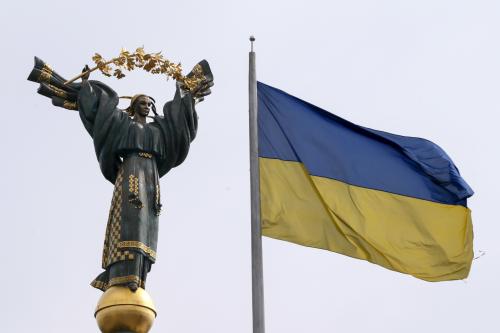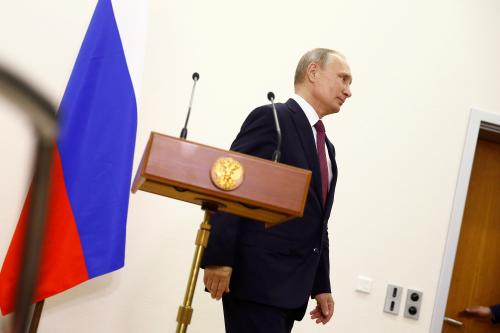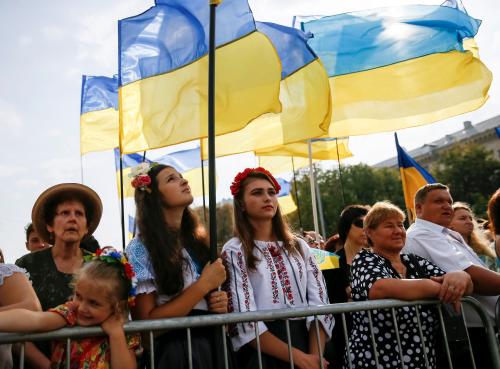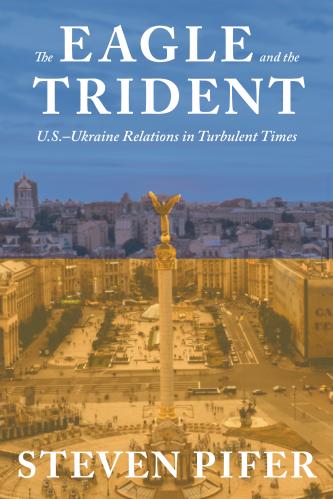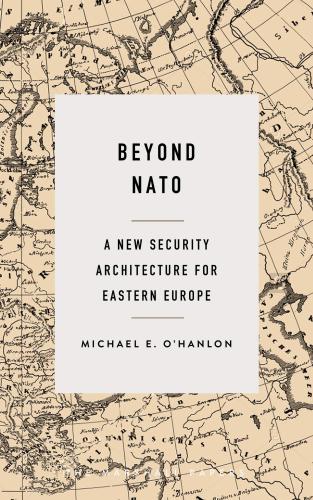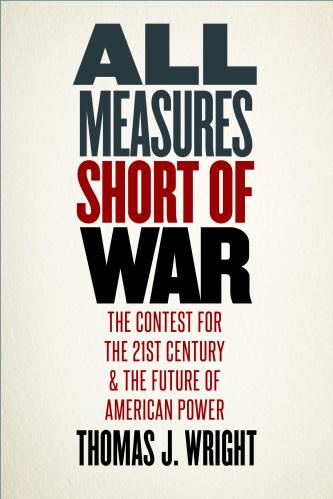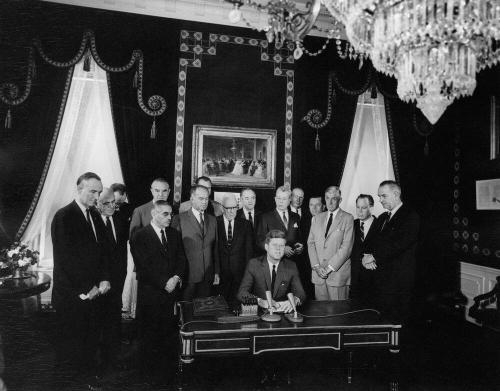This paper was originally published by the Valdai Discussion Club.
For nearly 50 years, arms control agreements have contributed to more stable and predictable relations between Washington and Moscow. Beginning in the late 1980s, agreements such as the Intermediate-Range Nuclear Forces (INF) Treaty followed by the first Strategic Arms Reduction Treaty (START I) went beyond mere limitations to impose significant reductions on U.S. and Soviet (and then Russian) nuclear forces.
Unfortunately, the U.S.-Russia relationship has hit its lowest point since the Cold War. Ensuring strategic stability — a situation in which neither side has a strong incentive to strike first, even in a severe crisis — faces numerous challenges. These challenges include nuclear force modernization efforts by both countries, related questions such as missile defense and prompt conventional strike, possible doctrinal changes, developments in the cyber and space domains, the effect of third-country nuclear forces and the increased possibility of accidents or miscalculation stemming from more frequent encounters between U.S. and Russian military forces.
Existing negotiated arms control and military transparency regimes are fraying in the face of these challenges. Moscow seems less interested in formal arms control agreements than in the past, and the U.S. government has found that Russia is in violation of the INF Treaty. In Washington, a new administration seems to attach less value to arms control than its predecessor did, while Republicans on Capitol Hill support measures that could end U.S. compliance with existing treaties.
All this opens a risk that the strategic competition between the two nuclear superpowers could become less bound by formal agreement and more opaque. Indeed, there is a prospect that, in 2021, for the first time in five decades, no negotiated agreements will be regulating the U.S.-Russian nuclear arms relationship.
Such a breakdown is in neither side’s interest. U.S. and Russian officials should seek to preserve the existing arms control regime and explore how to strengthen it. Overcoming stark differences over other problem questions, such as Ukraine, Syria and interference in domestic election processes, will require hard and patient work. As in the past, progress on nuclear arms control could contribute to an improvement in the broader bilateral relationship.
Maintaining the existing arms control regime: INF and new START
Preserving existing agreements should be a priority. The INF Treaty is at risk. Washington has found that Russia has violated it by testing and deploying an intermediate-range ground launched cruise missile, apparently an extended range version of the Iskander-K, designated SSC-8. Moscow denies the U.S. charge and claims that the U.S. military has violated the treaty in three ways. The Russian government asserts that the United States uses prohibited intermediate-range ballistic missiles in missile defense tests; that U.S. armed unmanned aerial vehicles (UAVs) are the equivalent of the banned intermediate-range ground-launched cruise missiles; and that the Aegis Ashore missile defense site in Romania (and a second under construction in Poland) can house and launch intermediate-range cruise missiles. While the first two charges lack foundation, there appears to be some substance to the third charge regarding the Aegis Ashore.
The sides thus far have been unable to resolve these compliance concerns. Congressional Republicans have proposed and passed legislation calling on the United States to develop its own intermediate-range missile, though the Trump administration’s current focus appears to be on measures that might bring Russia back into compliance.
With political will, there are ways to settle the compliance issues; solutions could be worked out in the Special Verifi cation Commission (SVC) established by the INF Treaty. Russia could host a U.S. team, exhibit an SSC-8, and provide a briefing on the missile’s characteristics with a view to resolving the U.S. concern. One question for focus could be the SSC-8’s fuel tanks and whether they have sufficient fuel capacity for the missile to travel to intermediate range. Obviously, if the SSC-8’s range exceeds 500 kilometers (the threshold for intermediate range), the missile and its associated launchers would have to be eliminated.
As for Moscow’s charges, U.S. and Russian offi cials at the SVC could work out language drawing a clear distinction between prohibited intermediate-range ballistic missiles and ballistic missiles used in missile defense tests and could also develop a language to differentiate armed UAVs from the banned cruise missiles. The sides could work out a combination of observable differences and Russian visits to the Aegis Ashore sites to confirm that those sites deploy only SM-3 missile interceptors, not cruise missiles.
The main question is whether the sides will act to preserve the INF Treaty.
The prospects for the New START Treaty appear better. U.S. and Russian officials have affirmed that they will meet the treaty’s limits, which take full effect in February 2018. Both countries appear on track to do so.
New START by its terms expires in February 2021, but the treaty can be extended for up to five years. New START’s constraints and transparency measures promote stability between the United States and Russia. The two countries should explore an early extension of the treaty, though U.S. offi cials have indicated that they would wait for completion of the administration’s nuclear posture review and see how the New START limits have been implemented before deciding on any extension.
New START extension could prove an early ‘win’ for both Washington and Moscow. Extension would maintain the stability, limits and transparency provided by the treaty to 2026 and would give Washington and Moscow more time to determine whether to pursue further arms control measures. The U.S. military leadership’s support for extension would insulate the White House against charges of an improper concession to Moscow. A complicating factor on the American side, however, is that Congress has passed legislation that would deny funding for any extension of New START if Russia is not in compliance with the INF Treaty.
Reducing the Risk of Miscalculation
The past several years have seen a dramatic increase in the number and kinds of encounters between U.S. and Russian military aircraft and warships. These encounters raise the risk of accident or miscalculation. As a second matter of priority, it would serve the interests of both countries to reduce such risks (this implies that ‘leaving it to chance’ is not a calculate Kremlin policy). Washington and Moscow have antecedents on which to draw.
Agreement on the Prevention of Incidents On and Over the High Seas. This 1972 agreement governs encounters between U.S. and Russian warships and military aircraft in and over international waters. Washington and Moscow should open a military-to-military channel to consider possible updating of the agreement. They could explore multilateralizing the procedures so that they would cover all NATO countries and Russia, and perhaps third countries such as Sweden and Finland. U.S. and Russian military officials might also consider whether it would make sense to incorporate elements of the Code for Unplanned Encounters at Sea agreed to by 21 Pacific Ocean navies in a NATO-Russia arrangement.
Agreement on the Prevention of Dangerous Military Activities. This 1989 agreement regulated U.S.-Soviet ground force activities along the inner-German border. With U.S. and other NATO ground forces deployed in Poland and the Baltic states, U.S. and Russian officials should consider an updated version of the 1989 agreement, this one negotiated between NATO and Russia and applying to northern Poland, Kaliningrad, the Baltic states and Russia’s Pskov region.
Revive Cooperative Airspace Initiative. This arrangement began operating in 2011 and provided for the exchange of information and radar tracks between NATO and Russian civil air traffic control centers along the NATO-Russia border. NATO suspended it in 2014 following Russia’s seizure of Crimea. U.S., NATO and Russian offi cials should discuss the value of restoring the arrangement to reduce the risk of accidents in the air.
Vienna Document. NATO and Russia have significantly increased the frequency and size of their military exercises over the past several years. Certain exercises — such as Zapad-2017 — have generated significant concern. It would make sense for U.S. and Russian officials to look at updating the thresholds in the Vienna Document (e.g., for notifications) with a view to reducing the risk that NATO might misinterpret a Russian exercise or vice-versa. These ideas could then be taken up by OSCE members in Vienna. In the meantime, U.S. and Russian officials should explore greater use of the document’s provision that provides for voluntary hosting of visits to dispel possible concern regarding military activities.
Strategic stability talks
U.S. Secretary of State Rex Tillerson and Russian Foreign Minister Sergey Lavrov agreed on strategic stability talks spring 2017, and the first round was held in Helsinki on September 11. These talks offer a venue for exploring next steps for the United States and Russia, even if prospects for early progress appear remote. One question that the sides need to sort out is what topics should be addressed in the strategic stability talks. An overly broad agenda risks bringing in issues — such as election interference or the Ukraine-Russia conflict — that are difficult, but do not impact directly on strategic stability, at least not as the term has been understood in the past. Those problems can and should be addressed in other U.S.-Russian channels.
It is equally true, however, that the agenda needs to broaden beyond the factors that were considered as key to strategic stability during the Cold War: nuclear force structures and numbers, military doctrine and missile defense. For example, nuclear arms reductions, properly structured, will contribute to greater stability, but they need to be considered in a broader context than was the case during the Cold War.
As the sides pursue these exchanges, possible topics should include nuclear arms, military doctrine, missile defense, advanced conventional strike weapons, the impact of third country nuclear forces, the cyber and space domains, and how arms control arrangements might contribute to stability. Even if the talks do not result in specific negotiations, the process could be useful in and of itself as a venue for understanding and possibly alleviating the other side’s concerns. Among the topics that would make sense for strategic stability talks are the below mentioned ones.
Nuclear force modernization. Russia is well into its nuclear modernization program, building Borey-class ballistic missile submarines, new submarine-launched ballistic missiles (SLBMs), new intercontinental ballistic missiles (ICBMs) and reopening the Blackjack strategic bomber production line. Russia is also modernizing its non-strategic nuclear weapons. The United States has begun its strategic modernization program, which will accelerate in the 2020s and includes the Columbia-class ballistic missile submarine, a new ICBM, the B-21 bomber and possibly a new nuclear-armed cruise missile. The U.S. military is also modernizing its sole nonstrategic nuclear weapon, the B61 gravity bomb (which will also equip strategic bombers).
Much of the Russian and U.S. strategic modernization programs give little reason for concern. They are largely about replacing old systems, whose service life is ending, with new systems. Still, it would be useful for officials from the two countries to exchange views on their nuclear force modernization programs, with a view to understanding future force structures and their implications for strategic stability. Such an exchange would also provide an opportunity for officials to flag programs of the other side that seem particularly threatening.
Nuclear arms control. As noted above, priority should be given to preserving the INF Treaty and New START. Looking to the longer term, the United States and Russia each maintain some 4,000 nuclear weapons in their stockpiles — more than ten times the number of any third country. The sides might discuss what possibilities they see for further nuclear arms reductions. Ideally, this would include non-strategic nuclear weapons and reserve strategic warheads not covered by New START. If the United States and Russia hope to involve third-country nuclear powers in negotiations at some future point, they will need to be prepared to limit all of their nuclear arms, as many nuclear weapons deployed by third countries would not be captured by the “strategic” definitions of New START.
Russian and the U.S. Military Doctrine. Russian Military Doctrine, published in 2014, says that Moscow would use nuclear weapons in response to an attack on Russia or a Russian ally with nuclear or other weapons of mass destruction, or in the event of an attack on Russia with conventional forces in which the existence of the state was at stake. That is relatively unremarkable. But experts in the West worry that Moscow has adopted a doctrine — often referred to as “escalate to de-escalate” — in which Russia might use one or several small nuclear weapons to terminate a conventional conflict on Moscow’s terms. In contrast, Russian experts assert that “escalate to de-escalate” is not official doctrine. The Pentagon and NATO, however, have begun adjusting nuclear policies to take account of their belief that the Russian military intends and plans to use nuclear weapons if it is losing a conventional conflict, regardless of who started the conflict or whether the existence of the Russian state is a stake.
At the least, there is a risk of a serious miscommunication. It would be useful for the sides to have a common understanding of this doctrine — and its official status. It would also be useful for Russian officials to have an understanding of how the United States and NATO would respond to a Russian first use of nuclear weapons in the case of a conventional conflict initiated by Moscow.
Russian officials have expressed concern about U.S. missile defense programs and “conventional strategic strike” capabilities. They might welcome a dialogue on U.S. missile defense plans and U.S. doctrine regarding conventional strike—and how these programs (and their Russian equivalents) affect strategic stability. The sides would have to approach this exchange in a way that did not lead to a ‘dialogue of the deaf,’ as has happened in the past.
Another question is whether informal steps might be taken to lower the pressures for a quick decision on nuclear use. For example, Washington has reduced the role of “launch under attack” for its ICBMs in U.S. planning while retaining the ability. Could the sides adopt measures, even if unverifi able, that might slow the pace of an escalating crisis and allow more time for considered decision-making? They might discuss other steps to de-alert strategic forces, though the stability consequences of some actions, such as removing warheads from a portion of each side’s ICBM force, would need to be carefully weighed.
Missile defense. Moscow remains concerned about U.S. missile defense programs. Given views in the U.S. Senate, however, it is virtually impossible to see a treaty that limits missile defense securing consent to ratification in the foreseeable future. That is a problem on the American side, but it is a limiting factor that both sides must take into account. They should consider whether lesser measures — such as a missile defense transparency agreement along the lines proposed by Washington in 2013 — could help defuse the missile defense issue.
The Joint Comprehensive Plan of Action with Iran limits any near-term Iranian threat to conventionally-armed ballistic missiles. Such missiles pose a far lesser threat than a nuclear-armed ballistic missile. This could give grounds for reconsidering the European phased adaptive approach to missile defense, in particular, whether the SM-3 missile defense site in Poland needs to be completed and SM-3 interceptors deployed there. Others argue that NATO should reorient its missile defense against Russian missiles in view of the deterioration in relations between the West and Russia (though it is unclear how much of a contribution SM-3s could make to such a missile defense, given that Russia at present deploys no intermediate-range ballistic missiles). Missile defense in Europe is an important topic for discussion.
North Korea’s aggressive ballistic missile program has led to deployment of the U.S. Theater High-Altitude Area Defense (THAAD) system in South Korea. Absent some restraint on the North Korean side, there will be pressure for additional increases in U.S. missile defenses in the region and an increase in the number of ground-based interceptors in Alaska for homeland defense. That will concern Russia (and China). While Moscow may lack the influence to affect North Korean calculations and actions, a discussion of missile defense in Northeast Asia might be useful for helping Russian officials to understand U.S. concerns as well as for helping U.S. officials to appreciate Russian concerns about new missile defense deployments.
Precision-guided conventional strike. Moscow has expressed concern about U.S. conventional strike capabilities and linked that issue to a discussion of further nuclear arms reductions. Some Russian experts worry that the United States seeks the capability to destroy a significant portion of Russian strategic forces with conventional means.
That said, Russia has demonstrated that it has begun to close the gap with the United States in conventionally armed sea- and air-launched cruise missiles. The sides could discuss how their growing reliance on such weapons affects the overall strategic balance between the two. They could also address the questions raised by possible future conventional prompt global strike systems, such as hypersonic glide vehicles. The sides have an opportunity to discuss such systems, their potential impact on strategic stability, and the possibilities for constraining them now — before actually deploying them.
Third-country nuclear forces. China’s nuclear forces affect calculations in Washington and Moscow. North Korea’s nuclear and ballistic missile programs increasingly impact U.S. thinking and have prompted steps such as deployment of the THAAD missile defense to South Korea. U.S.-Russia strategic stability talks could address how the stability in the relationship between the two countries is affected by these and other decisions taken by third countries.
Russian officials rejected U.S. proposals following the conclusion of the New START Treaty for a bilateral negotiation aimed at further nuclear arms reductions. Instead, they proposed that the next negotiation should be multilateral, presumably including at least Britain, France and China. Moscow, however, has offered no specific proposals for the outcome of such a negotiation. Given the disparity in nuclear weapons numbers between the United States and Russia, on the one hand, and the other three countries, on the other, finding an outcome acceptable to all seems virtually impossible.
Equal limits on all five countries would either require deeper reductions than Moscow and Washington are prepared to make, or allow the other three significant room to expand their forces (even though none of the countries would likely use that room). Third countries would insist on equality in a treaty; they would not accept a nuclear arms control variant of the 1922 Washington Naval Treaty, which established limits for capital warship tonnage for the United States, Britain, Japan, France and Italy in a 5:5:3:1.75:1.75 ratio. The difficulty of finding a proposal that has any prospect of being considered seriously by all five countries, to say nothing of the other nuclear weapons states, undoubtedly explains why Moscow, while calling for a multilateral negotiation for five years now, has put forward no specific ideas as to how to structure such a negotiation.
An alternative and possibly workable approach would center on a bilateral U.S.-Russian treaty providing for nuclear arms reductions that go beyond those required by New START combined with unilateral political-binding commitments by the other three countries not to increase the total numbers of their nuclear weapons. In addition, the United States, Russia, Britain, France and China might consider continuing their earlier P5 talks and take up the subject of maintaining strategic stability — or at least avoiding steps that would undermine it — in a multilateral model.
Cyber and space domains. The U.S. and Russian militaries increasingly have to consider how operations in the cyber and space domains affect operations on land, sea and air, including the nuclear area. Strategic stability talks could provide a venue for discussion of how developments in these new domains affect strategic stability. Since the sides’ doctrines on operations in these domains and governing cross-domain actions are evolving, formal agreements are unlikely in the near term. U.S. and Russian officials might, however, explore less formal rules of the road, such as no cyber-attacks against the other side’s strategic warning systems and the avoidance of activities in space that create additional space debris.
Towards a new model of strategic stability. Strategic stability in the Cold War essentially focused on the balance between U.S. and Soviet offensive strategic nuclear forces, with some attention to missile defense. Many more factors affect strategic stability today, which is evolving from a bilateral strategic offense-defense concept to a multilateral and multi-domain construct. That will be a far more complex stability model. Strategic stability talks offer a logical venue for U.S. and Russian officials to sort through the implications.
For these talks to achieve minimum results, each side would need to be prepared to be candid about its plans and programs. Signifi cant progress could require that the sides discuss issues that one or the other has not been comfortable discussing in the recent past, such as constraints —formal or informal — on non-strategic nuclear weapons and missile defense programs.
Conclusion
There are ways to bridge U.S.-Russian differences on nuclear arms reductions and related issues, if the political will emerges. For example, Moscow could respond to U.S. and NATO concerns by addressing the issue of non-strategic nuclear weapons and limits on such weapons, while Washington may be able to take some steps to take account of Russian concerns regarding missile defense and precision-guided conventional strike weapons. In the current political environment, however, it is unrealistic to expect early progress on these questions. The prospects could increase with an improvement in the overall political atmosphere.
It would make sense for U.S. and Russian officials to focus first on maintaining the existing nuclear arms control regime. According to the September 1, 2017, data exchange, both sides are very close to reaching the New START limits that take full effect in February 2018. Preserving and extending New START would be a positive step, as would be preservation of the INF Treaty. U.S. and Russian officials should also focus on small steps that could reduce the risk of accident or miscalculation. Success on those questions could generate momentum that might help improve the broader U.S.-Russia relationship and create conditions for U.S. and Russian officials to tackle larger and more ambitious issues.
It is clear, however, that the sides need to do something or watch as the current nuclear arms control regime — particularly the INF Treaty — continues to fray. Absent proper attention, the regime will further deteriorate, as will its contribution to strategic stability. That is in neither side’s interest. The prospective collapse of the nuclear arms control regime should serve as a spur to action in both Washington and Moscow.


